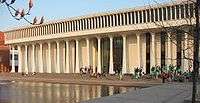Minoru Yamasaki
| Minoru Yamasaki | |
|---|---|
 | |
| Born |
December 1, 1912 Seattle, Washington, U.S. |
| Died |
February 6, 1986 (aged 73) Detroit, Michigan, U.S. |
| Nationality | American |
| Alma mater | University of Washington, New York University |
| Occupation | Architect |
| Projects | Federal Reserve Bank of Richmond, Rainier Tower, IBM Building, World Trade Center |
| Design | Inspiration by Gothic architecture and usage of narrow vertical windows |
Minoru Yamasaki (December 1, 1912 – February 6, 1986[1][2]) was an American architect, best known for designing the original World Trade Center in New York City and several other large-scale projects.[3] Yamasaki was one of the most prominent architects of the 20th century. He and fellow architect Edward Durell Stone are generally considered to be the two master practitioners of "New Formalism".[4]
Early life and education
Yamasaki was born in Seattle, Washington, a second-generation Japanese American, son of John Tsunejiro Yamasaki and Hana Yamasaki.[5] He grew up in the slums of that city and was bullied for his ethnicity.[3] The family moved to Auburn, Washington and he graduated from Garfield Senior High School in Seattle. He enrolled in the University of Washington program in architecture in 1929, and graduated with a Bachelor of Architecture (B.Arch.) in 1934.[6] During his college years, he was strongly encouraged by faculty member Lionel Pries. He earned money to pay for his tuition by working at an Alaskan salmon cannery.[7]
After moving to New York City in the 1930s, he enrolled at New York University for a master's degree in architecture and got a job with the architecture firm Shreve, Lamb & Harmon, designers of the Empire State Building. In 1945, Yamasaki moved to Detroit, where he was hired by Smith, Hinchman & Grylls.[8] The firm helped Yamasaki avoid internment as a Japanese-American during World War II, and he himself sheltered his parents in New York City.[5][9] Yamasaki left the firm in 1949, and started his own partnership.[8] One of the first projects he designed at his own firm was Ruhl's Bakery at 7 Mile Road and Monica Street in Detroit.[10] In 1964, Yamasaki received a D.F.A. from Bates College.
His firm, Yamasaki & Associates, closed on December 31, 2009.[11]
Career
His first internationally recognized design, the Pacific Science Center with its iconic arches, was constructed by the City of Seattle for the 1962 Seattle World's Fair.[5] His first significant project was the Pruitt–Igoe housing project in St. Louis, Missouri, 1955. Despite his love of Japanese traditional design, this was a stark, modernist concrete structure. The housing project experienced so many problems that it was demolished in 1972, less than twenty years after its completion. Its destruction is considered by some to be the beginning of postmodern architecture.[3]
In 1955, he also designed the "sleek" terminal at Lambert–St. Louis International Airport which led to his 1959 commission to design the Dhahran International Airport in Saudi Arabia. During this period, he created a number of office buildings which led to his innovative design of the 1,360 ft (410 m) towers of the World Trade Center in 1964,[12] which began construction March 21, 1966. The first of the towers was finished in 1970.[13] Many of his buildings feature superficial details inspired by the pointed arches of Gothic architecture, and make use of extremely narrow vertical windows. This narrow-windowed style arose from his own personal fear of heights.[14] One particular design challenge of the World Trade Center's design related to the efficacy of the elevator system, which was unique in the world. Yamasaki integrated the fastest elevators at the time, running at 1,700 feet per minute. Instead of placing a large traditional elevator shaft in the core of each tower, Yamasaki created the Twin Towers' "Skylobby" system. The Skylobby design created three separate, connected elevator systems which would serve different segments of the building, depending on which floor was chosen, saving approximately 70% of the space used for a traditional shaft. The space saved was then used for office space.[15]
In 1978 Yamasaki designed the Federal Reserve Bank tower in Richmond, Virginia. The work was designed with a similar appearance as the World Trade Center complex, with its narrow fenestration, and now stands at 394 ft (120 m).
Yamasaki was a member of the Pennsylvania Avenue Commission, created in 1961 to restore the grand avenue in Washington, D.C., but resigned after disagreements and disillusionment with the design by committee approach.[16]
After partnering with Emery Roth and Sons on the design of the World Trade Center, they collaborated on other projects including new buildings at Bolling Air Force Base in Washington, D.C.[17]
Yamasaki designed two notable synagogues during this period, North Shore Congregation Israel in Glencoe, Illinois in 1964 and Temple Beth El, in Bloomfield Hills, Michigan in 1973. He designed a number of buildings on the campus of Carleton College in Northfield, Minnesota between 1958 and 1968.[18]
Personal life
Yamasaki was first married in 1941 and had two other wives before marrying his first wife again in 1969. He died of stomach cancer in 1986.[19] His son, Taro Yamasaki, is a Pulitzer Prize-winning photographer.
Gallery
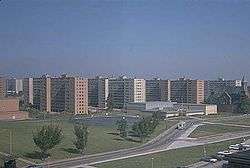 The former Pruitt–Igoe housing project, St. Louis 1954 (demolished 1972-1976)
The former Pruitt–Igoe housing project, St. Louis 1954 (demolished 1972-1976)
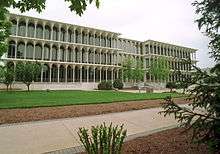 Irwin Library at Butler University, Indianapolis 1963
Irwin Library at Butler University, Indianapolis 1963- One Woodward Avenue, Detroit 1962

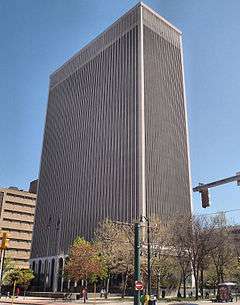
.jpg) The former World Trade Center 1970-1971 (destroyed in 2001)
The former World Trade Center 1970-1971 (destroyed in 2001)
 Rainier Tower, Seattle 1977
Rainier Tower, Seattle 1977
_10.jpg) Torre Picasso, Madrid 1988
Torre Picasso, Madrid 1988
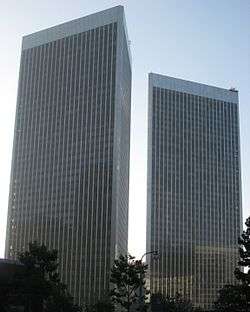 Century Plaza Towers, Los Angeles, 1975
Century Plaza Towers, Los Angeles, 1975
Honors
- Yamasaki was elected as a Fellow of the American Institute of Architects in 1960.
- Yamasaki won the American Institute of Architects' First Honor Award three times.[6]
- He was featured on the cover of Time magazine on 18 January 1963.[20]
See also
Notes
- ↑ Rimer, Sara (February 9, 1986). "Minoru Yamasaki, Architect of World Transit Center, Dies". The New York Times. Retrieved November 22, 2016.
- ↑ Murphy, Dean (February 9, 1986). "Architect Minoru Yamasaki Dies at 73: Designs Include Century Plaza Towers, N.Y. World Trade Center". The Los Angeles Times. Retrieved November 22, 2016.
- 1 2 3 Justin Davidson (August 27, 2011). "The Encyclopedia of 9/11: Yamasaki, Minoru: An architect whose legacy didn't work out as he'd planned". New York.
- ↑ "Architecture and Design of the Music Center". Performing Arts Center of Los Angeles County. Retrieved March 30, 2011.; excerpting from HABS documentation: "Los Angeles Music Center". Historic American Building Survey.
- 1 2 3 Crowley, Walt (3 March 2003). "Yamasaki, Minoru (1912-1986), Seattle-born architect of New York's World Trade Center". HistoryLink.org. Retrieved 2012-11-17.
- 1 2 Milton Esterow (21 September 1962). "Architect Named for Trade Center". The New York Times. NYTimes.com.
- ↑ "Center Will Reflect Architectural Collaboration". The New York Times. NYTimes.com. January 19, 1964.
- 1 2 Huxtable, Ada Louise (November 25, 1962). "Pools, Domes, Yamasaki - Debate". The New York Times.
- ↑ "Minoru Yamasaki 1912-". encyclopedia.com. Retrieved 2012-03-15.
- ↑ Interview with owner's daughter. Original architectural drawings donated to the University of Michigan.
- ↑ John Gallagher (28 January 2010). "A Once Eminent Firm Meets a Bitter End". Architectural Record. construction.com. Retrieved 2012-11-17.
- ↑ Remarks by the Hon. Richard J. Hughes, World Trade Center Press Conference, New York Hilton Hotel, Jan. 18, 1964
- ↑ "History of the Twin Towers". Port Authority of New York and New Jersey. Retrieved 2014-12-12.
- ↑ James, Glanz; Lipton, Eric (2003). City in the sky: the rise and fall of the World Trade Center. Macmillan. p. 109. ISBN 978-0-8050-7428-4.
- ↑ Remarks by Lee K. Jaffee, World Trade Center Press Conference, New York Hilton Hotel, January 18, 1964
- ↑ Huxtable, Ada Louise (2 February 1964). "N.Y.C. Architectural Ups and Downs". The New York Times. NYTimes.com.
- ↑ Robbins, William (26 March 1967). "2 Firms Are Welding Abilities to Plan World Trade Center". The New York Times. NYTimes.com. Retrieved 2012-11-17.
- ↑ "Why is my Dorm so Ugly?". Carleton College. 24 February 2009. Retrieved 2012-11-17.
- ↑ "Minoru Yamasaki Biography (Architect) —". Infoplease.com. Retrieved 2012-03-15.
- ↑ "Time Magazine Cover for 18 Jan 1963".
References
- Yamasaki, Minoru, A Life in Architecture, Weatherhill, NY 1979 ISBN 0-8348-0136-1
- Nobel, Philip, Sixteen Acres: The rebuilding of the World Trade Center site, Granta, London 2005 ISBN 1-86207-713-4
External links
| Wikimedia Commons has media related to Minoru Yamasaki. |
- GreatBuildings.com listing
- The Wayne State University Yamasaki Legacy
- Minoru Yamasaki interview, [ca. 1959 Aug.] - Archives of American Art
- Hadley, Jane (September 13, 2001), "Seattle architect created trade center as peace symbol", The Seattle Post-Intelligencer
- Images from the Minoru Yamasaki Collection Walter P. Reuther Library
